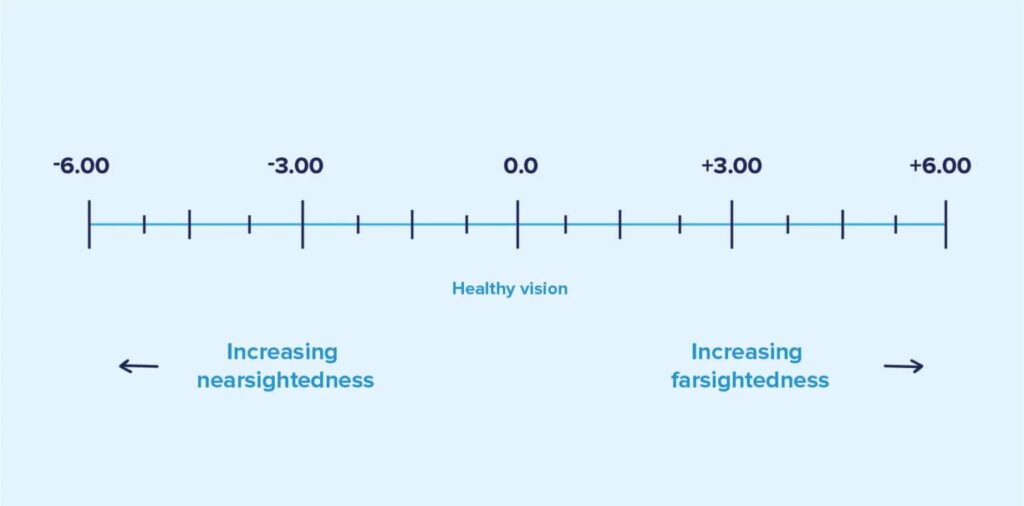How to Read Your Eye Prescription
What are Eye Prescriptions?

Eye prescriptions are written instructions provided by an optometrist or ophthalmologist to correct someone’s vision. They specify the type and extent of visual correction required, typically in the form of glasses or contact lenses, and include parameters such as sphere, cylinder, axis, and add power. The values in the prescription help to determine the lens power needed to correct nearsightedness, farsightedness, astigmatism, or other vision issues.
Eye prescriptions can seem complicated, but we’ll break down each component to help you decipher it. Understanding your prescription not only improves your knowledge of your eyewear, but also adds a useful party trick to your skill set.

Your Glasses Prescription, Explained
Your eye prescription may appear as a small table or chart with rows, columns, and cells, either in paper or digital form. It can be confusing as it contains a combination of abbreviated letters, positive and negative numbers, and full words.
Eye Prescription Abbreviations
- OD: Right Eye. OD stands for “oculus dexter” in Latin, meaning “right eye”. The word “dextrous” and “dexterity” also come from the same root.
- OS: Left Eye. OS stands for “oculus sinister” in Latin, meaning “left eye”. The word has no moral connotation, just indicating direction.
- OU: Both Eyes. OU stands for “oculus uterque” in Latin, meaning “both eyes”.
- NV: Close-up Vision. NV stands for “near vision”, referring to the ability to see things up close.
- DV: Far Vision. DV stands for “distance vision”, referring to the ability to see things far away.
- PD: Pupillary Distance. PD is the measurement of the distance between the pupils. It helps in aligning the lens center with the pupil center for accurate vision. Your eye doctor may include PD in your prescription, or you can use an online tool to measure it.
- SPH: Sphere Correction. SPH stands for “sphere” and refers to equal correction for nearsightedness or farsightedness in all meridians of the eye. The correction is indicated by numbers in the SPH column.
Eye Prescription Scale
- Diopters: The numbers in the “Sphere” or “Cyl” column of your prescription indicate diopters, a unit of measurement for lens refractive power. A higher prescription means more optical power, represented by larger numbers. Lower numbers indicate less correction is needed. The numbers can be positive or negative, depending on the type of refractive error. A person with perfect vision would have a prescription of 0 diopters.
- Negative Numbers: A negative sign in front of a number means nearsightedness (myopia). For example, -3 diopters of nearsightedness could result in difficulty reading a chalkboard from a distance.
- Positive Numbers: A positive sign in front of a number indicates farsightedness (hyperopia) correction. For example, +3 diopters of farsightedness could make it hard to read text close up.
Other Terms on Your Eye Prescription
Your eye prescription may contain additional terms, depending on the type of lenses required, such as:
- CYL or Cylinder: This term only applies to individuals with astigmatism and refers to the lens power required to correct it. Astigmatism occurs when the eye’s cornea or lens is not perfectly spherical, requiring cylindrical, not spherical, vision correction. If there is no number on the prescription, it means you have no astigmatism to correct.
- Axis: For astigmatism patients, the axis is a number (1 to 180) on the prescription that determines the orientation of the astigmatism correction. The axis is measured in degrees, not diopters, and must always accompany the cylinder.
- Add: Additional magnification is available for individuals with presbyopia who have difficulty reading close up. A section of the glasses lenses can be reserved for added magnifying power, like having reading glasses built into your regular glasses.
- Prism: Double vision can result from misaligned eyes, such as strabismus (crossed eyes). To correct this, a prism can be added to the lenses. The position and orientation of the prism are based on the prescription, which also indicates the direction of the thickest edge (base) of the prism: BU (base up), BD (base down), BI (base in), BO (base out). The refractive strength of the prism is measured in prism diopters.
- Expiration Date: Your eye prescription may change over time, so regular eye exams are important to ensure optimal vision. Eye prescriptions are usually valid for one to two years and vary by state law. After the expiration date, an eye exam is required to renew the prescription.
What About Contact Lens Prescriptions?
You may be curious: Do my contact lens and glasses prescriptions match? The answer is not always. Glasses sit a small distance away from your eyes, whereas contact lenses sit directly on your corneas, so their prescriptions may differ. Moreover, due to the fixed parameters set by contact lens manufacturers, your doctor may need to make adjustments to your contact prescription, further separating it from your glasses prescription.
Even if the prescription values for your contact lenses and glasses are the same, your contact lens prescription must specify the brand name (e.g. Acuvue, clariti, DAILIES, etc.). Your eye doctor must also include information about the fit of the contact lenses on your prescription, as a proper fit is essential for comfort and vision.
Contact Lens Prescription Abbreviations
- Base Curve (BC): A contact lens’s curvature, which should conform to the curvature of your eye for a comfortable fit. This measurement is expressed in millimeters (mm) and falls within the range of 8 to 10.
- Diameter (Dia): The diameter of a contact lens, measured in millimeters (mm), refers to the width of the lens. The typical range for contact lens diameter is between 13mm and 15mm.